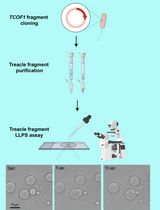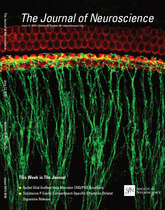- Submit a Protocol
- Receive Our Alerts
- Log in
- /
- Sign up
- My Bio Page
- Edit My Profile
- Change Password
- Log Out
- EN
- EN - English
- CN - 中文
- Protocols
- Articles and Issues
- For Authors
- About
- Become a Reviewer
- EN - English
- CN - 中文
- Home
- Protocols
- Articles and Issues
- For Authors
- About
- Become a Reviewer
Aβ Extraction from Murine Brain Homogenates
Published: Vol 6, Iss 8, Apr 20, 2016 DOI: 10.21769/BioProtoc.1787 Views: 12398
Reviewed by: Oneil G. BhalalaGeoff LauKae-Jiun Chang

Protocol Collections
Comprehensive collections of detailed, peer-reviewed protocols focusing on specific topics
Related protocols

Protocol for the Preparation of a Recombinant Treacle Fragment for Liquid–Liquid Phase Separation (LLPS) Assays
Nadezhda V. Petrova [...] Artem K. Velichko
Sep 20, 2025 1779 Views

A One-Step Mouse Model of Parkinson’s Disease Combining rAAV-α-Synuclein and Preformed Fibrils of α-Synuclein
Santhosh Kumar Subramanya [...] Poonam Thakur
Dec 5, 2025 1551 Views

Optimized Secretome Sample Preparation From High Volume Cell Culture Media for LC–MS/MS Proteomic Analysis
Basil Baby Mattamana [...] Peter Allen Faull
Dec 20, 2025 1101 Views
Abstract
This protocol details beta-amyloid (Aβ) extraction from transgenic murine brain homogenates. Specifically, mechanical homogenization of brain tissue and sequential extraction of both soluble and insoluble proteins are detailed. DEA extracts soluble proteins, such as Aβ isoforms and APP. Formic acid enables extraction of insoluble protein aggregates, such as Aβ isoforms associated with plaques. This procedure produces soluble and insoluble extracts that are amenable to analysis of Aβ species via western blotting and/or enzyme-linked immunosorbent assays (ELISAs), and these results help assess amyloidogenic burden in animals.
Keywords: Beta-amyloidMaterials and Reagents
- 5.0 ml open-top polyallomer ultracentrifuge tubes (or tubes capable of undergoing high-speed centrifugation) (Denville Scientific, catalog number: U5022 )
- Diethylamine (DEA) (≥ 99.5%) (Sigma-Aldrich, catalog number: 471216 )
- 95% formic acid (FA) (AMRESCO, catalog number: 0961 )
- 100 mM NaCl (store at room temperature)
- Tris base (Thermo Fisher Scientific, catalog numeber: BP152 )
- 0.5 M sodium phosphate dibasic (Na2HPO4) (AMRESCO, catalog numeber: 0348 )
- 0.05% sodium azide (NaN3) (Thermo Fisher Scientific, catalog numeber: S2271 )
- 250 mM sucrose (Thermo Fisher Scientific, catalog numeber: S5 )
- 0.5 mM Ethylenediaminetetraacetic Acid, Disodium Salt Dihydrate (EDTA) (Thermo Fisher Scientific, catalog numeber: S311 )
- 0.5 mM Ethylene glycol-bis(2-aminoethylether)-N, N, N’, N’-tetraacetic acid (EGTA) (Sigma Aldrich, catalog numeber: 03777 )
- Tris-hydrochloride (Tris-HCl)
- 0.4% DEA in 100 mM NaCl (see Recipes)
- 0.5 M Tris-HCl (pH 6.8) (see Recipes)
- Formic acid neutralization buffer (see Recipes)
- Tissue homogenization buffer (THB) (see Recipes)
- Protease inhibitor cocktail (Sigma-Aldrich, catalog number: P8340 ) (see Recipes)
Equipment
- Beckman Coulter Optima L-90K Ultracentrifuge (used with an SW50.1 rotor)
- Ultrasonic sonicator (see Note 7, below) (Kontes, model: KT50 , catalog number: 12038 )
Procedure
Note: The following protocol has been used to extract Aβ from multiple mouse models of Alzheimer’s disease [please see Cramer et al. (2012) and Casali et al. (2015)]. The user may need to modify dilutions of the final extracted product depending on the particular application (e.g., ELISA and/or Western blotting). Our lab usually dilutes DEA and FA fractions for Aβ ELISAs at least five-fold to fall within our in-house ELISA detection limits. For Western blots of Aβ and modified APP fragments, we recommend 10 to 50 micrograms protein per well, and for more details about Western blotting using the DEA-soluble extraction, please see Morales-Corraliza et al. (2012).
- Mechanical homogenization
- Mechanically homogenize brain tissue (see Note 1) in 850 µl cold THB buffer containing fresh protease inhibitor cocktail on ice. If using flash-frozen brains, immediately homogenize. Freshly dissected brains may also be used. Homogenize thoroughly enough such that a homogenous mixture results.
- Aliquot 250 µl of homogenate into 1.5 ml Eppendorf tubes for DEA/FA extraction on ice (see Note 2). Proceed to DEA/FA extraction below. If not immediately extracting, flash freeze samples on dry ice and store at -80 °C (Note 3).
- Mechanically homogenize brain tissue (see Note 1) in 850 µl cold THB buffer containing fresh protease inhibitor cocktail on ice. If using flash-frozen brains, immediately homogenize. Freshly dissected brains may also be used. Homogenize thoroughly enough such that a homogenous mixture results.
- DEA/FA Aβ extraction
- To 250 µl homogenate, add 250 µl (Note 4) 0.4% DEA and vortex rigorously until mixture appears homogenous.
- Transfer 500 µl of the homogenate/DEA sample to a tube capable of undergoing high-speed centrifugation.
- Using a swinging-bucket rotor (Note 5), perform a high-speed spin at 135,000 x g for 1 h at 4 °C.
- Remove 425 µl supernatant and neutralize with 42.5 µl 0.5 M Tris-HCl (pH 6.8). Vortex. Divide into 220 µl aliquots and flash-freeze on dry-ice. Store at -80 °C (Note 3). There will be a residual amount of soluble fraction remaining in the tube with the pellet that will not affect the downstream extraction-only remove 425 µl supernatant.
- Using the homogenate pellet that remains from step B4, add 125 µl cold formic acid (Note 6). Keep tubes on ice.
- Sonicate each sample on ice for 1 min continuously between output amplitude of 30-50 (Note 7). The pellet should dissolve after this amount of time. If not, sonicate until the pellet dissolves.
- Perform another high-speed spin at 109,000 x g for 1 h at 4 °C.
- Remove 105 µl sample, and add 1.895 ml of formic-acid neutralization buffer. Vortex and then divide into 2 x 1 ml aliquots and flash-freeze on dry-ice. Store at -80 °C (Note 3).
Note: For the expected yield of DEA soluble extracts and FA fractions, our lab routinely obtains between 1.0 to 3.0 mg/ml protein and approximately 0.1 to 0.5 mg/ml protein respectively.
- To 250 µl homogenate, add 250 µl (Note 4) 0.4% DEA and vortex rigorously until mixture appears homogenous.
Notes
- Our lab uses one brain hemisphere with cerebellum and midbrain removed and flash frozen on dry ice. Our lab does not remove brain meninges upon harvesting of the tissue.
- If performing other assays on brain tissue homogenate, aliquot the remaining homogenate accordingly for downstream application (e.g., Western blotting; RNA extraction; etc.).
- Provided storage at -80 °C in a properly functioning freezer and the samples are stored in tight-capped tubes, our lab has routinely used samples 6-months post-collection.
- The amount of DEA to add to homogenate is 1:1 (volume/volume).
- Usage of a swinging-bucket, or carriage, is essential in performing efficient extraction.
- The formic acid must be cold (i.e., chilled to at least 4 °C) in order to precipitate insoluble proteins.
- Our lab uses a Kontes micro-ultrasonic (20 KHz frequency) cell disrupter rated at 50-Watts power, 120 volts, and 2 amperes.
Recipes
- 0.4% DEA solution
200 µl DEA
1 ml 5 M NaCl
ddH2O to 50 ml
Stored at room temperature and use within 3 months - Formic acid neutralization buffer
1 M Tris base
0.5 M Na2HPO4
0.05% NaN3
Stored at room temperature and use within 3 months - Tissue homogenization buffer (THB)
2 mM Tris (pH 7.4)
250 mM sucrose
0.5 mM EDTA
0.5 mM EGTA
q.s. RNase-free H2O
Stored at 4 °C and use within 3 months
Note: “q.s.” means “quantity required”. - 0.5 M Tris-HCl (pH 6.8)
39.4 g tris-hydrochloride
q.s. ddH2O
Adjust pH to 6.8
Stored at room temperature and use within three months - Protease inhibitor cocktail
Use at 1:100 dilution and make fresh with each homogenization (if your desired downstream application examines phosphorylated proteins, add phosphatase inhibitors in addition to protease inhibitor cocktail).
Acknowledgments
This work was supported by a grant from the National Institutes of Health, R41-AG048658.
References
- Casali, B. T., Corona, A. W., Mariani, M. M., Karlo, J. C., Ghosal, K. and Landreth, G. E. (2015). Omega-3 fatty acids augment the actions of nuclear receptor agonists in a mouse model of Alzheimer's disease. J Neurosci 35(24): 9173-9181.
- Cramer, P. E., Cirrito, J. R., Wesson, D. W., Lee, C. Y., Karlo, J. C., Zinn, A. E., Casali, B. T., Restivo, J. L., Goebel, W. D., James, M. J., Brunden, K. R., Wilson, D. A. and Landreth, G. E. (2012). ApoE-directed therapeutics rapidly clear beta-amyloid and reverse deficits in AD mouse models. Science 335(6075): 1503-1506.
- Morales-Corraliza, J., Berger, J. D., Mazzella, M. J., Veeranna, Neubert, T. A., Ghiso, J., Rao, M. V., Staufenbiel, M., Nixon, R. A. and Mathews, P. M. (2012). Calpastatin modulates APP processing in the brains of beta-amyloid depositing but not wild-type mice. Neurobiol Aging 33(6): 1125 e1129-1118.
Article Information
Copyright
© 2016 The Authors; exclusive licensee Bio-protocol LLC.
How to cite
Readers should cite both the Bio-protocol article and the original research article where this protocol was used:
- Casali, B. T. and Landreth, G. E. (2016). Aβ Extraction from Murine Brain Homogenates. Bio-protocol 6(8): e1787. DOI: 10.21769/BioProtoc.1787.
-
Casali, B. T., Corona, A. W., Mariani, M. M., Karlo, J. C., Ghosal, K. and Landreth, G. E. (2015). Omega-3 fatty acids augment the actions of nuclear receptor agonists in a mouse model of Alzheimer's disease. J Neurosci 35(24): 9173-9181.
Category
Neuroscience > Nervous system disorders > Animal model
Biochemistry > Protein > Isolation and purification
Do you have any questions about this protocol?
Post your question to gather feedback from the community. We will also invite the authors of this article to respond.
Share
Bluesky
X
Copy link








